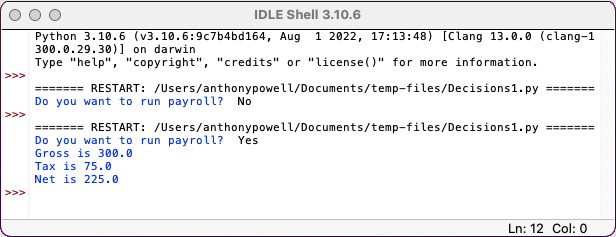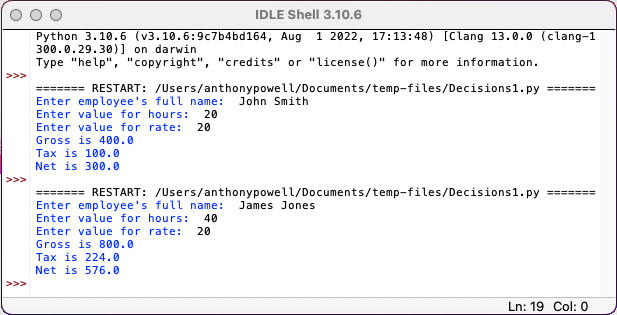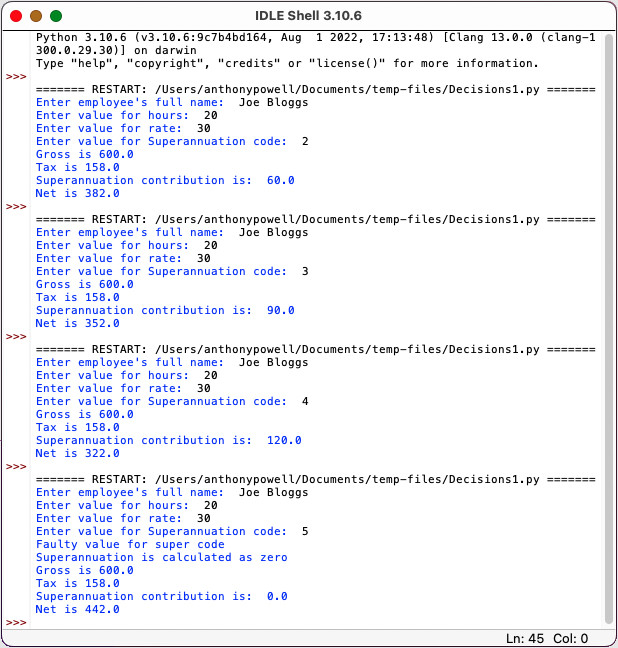NCEA Compatibility
Module: as91883 Develop a computer program
Requirements:Selection
Go to top
Module: as91883 Develop a computer program
Requirements:Selection
Go to topOn completion of this section you shall know:
In all aspects of life we make decisions. Examples are if the buses are running we shall go into town, otherwise we shall study. In programming we have to make decisions as well or to be more precise we shall tell the computer how to make decisions. To demonstrate this we shall modify the programme created in the previous chapter so tax is calculated in a different way. In the previous example we had a simple flat tax rate of 25%. In real life tax rates are never as simple as this. If the salary is low then the tax rate will also be low but a higher salary will incur higher tax rate. For this reason we shall modify the simple payroll programme we met in the previous lesson so that it will calculate tax in two different ways depending on the value of the gross pay.
Go to topfor our first example we shall look at a very simple example of decision making - the simplest if statement. This is shown in Listing 1 below.
#C2A Simple Payroll Programme
strDecision=input("Do you want to run payroll? ")
if strDecision=="Yes":
floatHours=20.0
floatRate=15.0
floatGross=floatHours * floatRate
floatTax=floatGross * 0.25
floatNet=floatGross-floatTax
print("Gross is " + str(floatGross))
print("Tax is " + str(floatTax))
print("Net is " + str(floatNet))
At first glance we see that most of the code is a repeat of that from the previous page. We notice, however, that a major change has occurred in the structure of the code.
There are two major changes:
What's this all about?
Line 3 is a condition. There are three indications to this:
All of line 3 could be translated into normal English as follows:
If the text entered by the user into the variable strDecision at line 2 is the word "Yes"
Similarly we can interpret the indented lines 4 - 11 as:
These lines will be executed if and only if the value stored in the variable strDecision is the word "Yes".
Another conclusion we can draw from this is that if the value stored in strDecision is NOT "Yes" then lines 4 - 11 are ignored. This would mean that only lines 2 and 3 would be executed and the rest would be ignored. This is shown in Fig 1 below.

In in the lesson ‘A simple Python Programme’ tax was calculated as a flat 25% of the gross. As stated above tax calculation is not quite this simple. Most governments have different levels of taxation depending on a person’s income level. In our case we shall assume that any gross which is $500 or less will be taxed at 25% whereas any gross that exceeds $500 will be taxed at 25% of the first $500 and 33% of the remainder.
The above scenario leaves us with a two way system for calculating tax: one way for gross less than 500 and another for gross greater than 500. Our simple example in Listing will not work in this case as it can allow for only a condition having a value of true. It has no ability to deal with the case of the condition being false. For this we need an extension of the if construct. This extension is the if..else construct.
Listing 2 shows how this construct works.
#C3Payroll Programme Decisions.py
strName=input("Enter employee's full name: ")
floatHours=float(input("Enter value for hours: "))
floatRate=float(input("Enter value for rate: "))
floatGross=floatHours * floatRate
if floatGross<500:
floatTax=floatGross * 0.25
else:
floatTax=125+(floatGross - 500) * 0.33
floatNet=floatGross-floatTax
print("Gross is " + str(floatGross))
print("Tax is " + str(floatTax))
print("Net is " + str(floatNet))
Apart from lines 6 to 9, the programme shown in Listing 2 is identical to the programme we met in the lesson ‘A simple Python Programme’. We shall therefore concentrate solely on this group of lines.
As stated earlier we need a programme that can make a decision between calculating the tax in one of two different ways. The main decision point is at line 6. Here we have the keyword if followed by the condition floatGross<500.
A condition, of course, can be either true or false. If the variable floatGross has a value of 400 then the condition is true, whereas if it has a value of 600 then the condition is false.
How does Python work with these conditions? At line 6 if floatGross has a value of 400 then the condition is true, since 400 is less than 500. In this case programme control passes to the body of the if, or in other words to line 7.
Notice that line 7 is indented by four spaces. As we stated earlier this means that this line will only be executed if the condition at line 6 is true. Thus if the value of floatGross is 400 then line 7 will be executed and a value of 100 will be stored in floatTax. Then control is passed to line 8.
Here the keyword else means that the indented lines that follow it will only be executed if the condition at line 6 is false. Following our example of floatGross having a value of 400 then line 7 would have been executed. After this control would pass to line 8. Since line 7 had already been executed the indented line following line 8 would be skipped. Thus at any one running of the program only line 7 or line 9 are executed; one of them is always executed while both of them are never executed.
Now let us examine a different scenario
Suppose that floatGross has a value of 800, then at line 6 the condition will be false since 800 is not less than 500. If this is the case programme control jumps from line 6 directly to line 9, thus skipping line 7. Again with floatGross having a value of 800 then at line 9 floatTax would be given a value of 125 +(800-500) * 0.33
This is equal to125 + 300 * 0.33
This simplifies to125 + 99
which is 224.
Figure 2 below shows two runnings of the programme, the first where floatGross has a value of 400 and the second where the same variable has a value of 800

The if..else construct, which we have encountered in the previous lesson is fine when we have only to choose between two alternatives. On the other hand if we have to choose between a larger number of alternatives, the if..else construct, even though it can handle the situation, can be very clumsy. In this situation we use the if..elif..else construct.
In order to explore this construct we shall extend our payroll application further so that it can handle superannuation calculation. Superannuation calculation normally involves taking a percentage of an employee’s pay and putting it into his superannuation account. The method we shall employ to calculate the contributions is that each employee is given a super code number and this number determines the percentage of their gross that will be deducted and put into their super account. In our case the percentage taken will be according to the following table:
| Super Code | Percentage |
|---|---|
| 0 | 0% |
| 1 | 5% |
| 2 | 10% |
| 3 | 15% |
| 4 | 20% |
What this means is that if the superannuation code is 0 then the employee pays no superannuation, whereas if the superannuation code is 1 then the employee pays 5% of his gross pay towards the superannuation. The same applies for the other possible values of the superannuation code.
On the other hand, if the value for superannuation is any number other than those in the range 0 – 4, then calculation proceeds and a message is printed indicating that a faulty superannuation code has been entered, but no contributions are deducted from the employee’s pay.
Below in Listing 3 we have the next upgrade on our payroll programme, where this version is able to work out superannuation contributions based on a superannuation code entered by the user. As always many of the lines in the programme correspond with its previous version, and again we will only concentrate on the new lines that we have added. These are line 5 and lines 11 - 24
Download Program Code
#C4Payroll Complex Decisions1.py
strName=input("Enter employee's full name: ")
floatHours=float(input("Enter value for hours: "))
floatRate=float(input("Enter value for rate: "))
intSuperCode=int(input("Enter value for Superannuation code: "))
floatGross=floatHours * floatRate
Line 5 is similar to the two lines above it except that instead of using the function float() it uses the function int() in order to convert the user’s input into an integer value, before storing that value in the variable intSuperCode. Also notice that the name of the variable starts with ‘int’ as a reminder to the user that the value contained in it is an integer.
if floatGross < 500:
floatTax=floatGross * 0.25
else:
floatTax=125+(floatGross - 500) * 0.33
if intSuperCode == 0:
floatSuperAmt = 0.0
elif intSuperCode == 1:
floatSuperAmt = floatGross * 0.05
elif intSuperCode == 2:
floatSuperAmt = floatGross * 0.1
elif intSuperCode == 3:
floatSuperAmt = floatGross * 0.15
elif intSuperCode == 4:
floatSuperAmt = floatGross * 0.2
else:
floatSuperAmt = 0.0
print("Faulty value for super code")
print("Superannuation is calculated as zero")
Lines 11 – 24 contain the if..elif..(else). This is a construct used when we need to check a variable for a number of values and perform a different action depending on the value. In our case we need to check the variable intSuperCode for values in the range 0 – 4 inclusive.
At line 11 it starts off with a normal if construct where intSuperCode is checked for a value of zero. If it does have a value of zero then line 12 is executed and zero is stored in floatSuperAmt. Once this line is executed then programme control jumps out of the if..elif..else construct and execution resumes at line 25.
If, on the other hand, intSuperCode has a value other than zero then line 12 is skipped and at line 13 it is checked for having a value of 1. Similarly at lines 15, 17 and 19 it is checked for the values 2, 3 and 4. Supposing it has a value of 2 then it is tested for a value of 1 at line 13. Since this will return a value of false line 14 is ignored and the variable is tested for a value of 2 at line 15. This will return a value of true and therefore line 16 is executed, where floatSuperAmt is given a value which is 10% of floatGross. Once this line is executed programme control jumps out of the if..elif..else construct and execution resumes at line 25.
Finally supposing that the value of intSuperCode is 12 or -5 or any other value that is not in the range 0 – 4, what happens with our construct? What happens is the value of intSuperCode is tested at lines 11, 13, 15, 17 and 19 and false is returned in all cases. Finally execution arrives at line 21 where it meets the else keyword. The fact that programme execution has reached the else means that intSuperCode has a value other than numbers in the range 0 – 4 and the code beyond beyond else, i.e. lines 22, 23 and 24, will be executed in order to deal with this situation. In our case what we wish to do is firstly inform the user that an out-of-range code was entered for the superannuation code and to set the superannuation contributions to zero.
floatNet=floatGross-floatTax-floatSuperAmt
print("Gross is " + str(floatGross))
print("Tax is " + str(floatTax))
print("Superannuation contribution is: " + str(floatSuperAmt))
print("Net is " + str(floatNet))
Line 25 finishes the calculation of the payroll by calculating the net and storing it in the variable floatNet.
The rest of the code i.e. lines 26 - 29, prints the values of the gross, tax, superannuation contributions and net on the screen
Fig 3 below shows the different outputs that the programme produces when on successive runnings the values 2, 3, 4 and 5 were entered for the superannuation code.

Copy the code in Listing 1into the programme into a text processor and save it. Next run it a number of times. Use different combinations of hours and rate so that some give a gross less than 500 and others give a gross greater than 500. Before running the programme each time first check using pen and paper what the values for the gross, tax and net should be, then check that the programme outputs against the same results.
Regarding lines 6 to 9 in Listing 2 above answer the following questions:
Decisions are an important part of programming. They allow a program to decide what to do based on the value of a variable. In Python the if construct is used to make a decision. The if construct is followed by a condition. If the condition is true then the indented block following the if is executed. If the condition is false then the indented block following the if is ignored.
When a program needs to make a decision between two alternatives the if..else construct is used. The if..else construct is followed by a condition. If the condition is true then the indented block following the if is executed. If the condition is false then the indented block following the else is executed.
When a program needs to make a decision between a number of alternatives the if..elif..else construct is used. The if..elif..else construct is followed by a number of conditions. The conditions are tested in order. If a condition is true then the indented block following the condition is executed and the rest of the construct is ignored. If no condition is true then the indented block following the else is executed.
Go to topModify the application you have created for Assignment Part 1 so that it can process customer discounts. If the subtotal is more than $100 then the customer receives a 5% discount otherwise no discount is given. The discount must be subtracted from the subtotal before the GST is calculated.
You must add an extra variable to your programme in order to hold the value of the discount. The value of the discount must be printed along with the other values.
Modify the program for the above assignment so that it can cater for a variety of discount codes.
Casual customers have a discount code of zero, while business customers have a discount codes varying from 1 to 6. The relationship between the discount code and percentage is shown in the following table.
| Discount Code | Percentage |
|---|---|
| 0 | 0% |
| 1 | 5% |
| 2 | 7% |
| 3 | 10% |
| 4 | 15% |
| 5 | 20% |
| 6 | 25% |
Other than the calculation of the percentage, the rest of the processing is the same as in Part 2 above.
Go to top